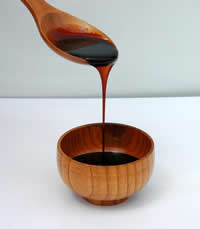Difference between Brown Sugar and Molasses
Key difference: Sugar is the generalized name for sweet-flavored food substances. Sucrose, table sugar, is mainly extracted from either sugarcane or sugar beet. Sugar, is available in many forms in the market. Molasses is a by-product of the sugar production process; be it of sugarcane fiber, beets or grapes. Brown sugar, which has gained popularity today, is white sugar with molasses added back in. When brown sugar is referred to as “raw sugar”, it is the sugar that has not been fully refined.
 Sugar is the generalized name for sweet-flavored food substances. Sugars are categorized as carbohydrates, which are a group of compounds made up of carbon, hydrogen and oxygen. Carbohydrates, and in turn sugars, are the source of chemical energy for living organisms, including humans. Sugars are categorized as monosaccharide, disaccharides and polysaccharides. Monosaccharides are the simplest carbohydrate type, composed of a single molecule. These include glucose, galactose, and fructose. Disaccharides are made up of two molecules. The table sugar, also known as sucrose, most commonly used by humans, is a type of disaccharide. Other disaccharides include maltose and lactose.
Sugar is the generalized name for sweet-flavored food substances. Sugars are categorized as carbohydrates, which are a group of compounds made up of carbon, hydrogen and oxygen. Carbohydrates, and in turn sugars, are the source of chemical energy for living organisms, including humans. Sugars are categorized as monosaccharide, disaccharides and polysaccharides. Monosaccharides are the simplest carbohydrate type, composed of a single molecule. These include glucose, galactose, and fructose. Disaccharides are made up of two molecules. The table sugar, also known as sucrose, most commonly used by humans, is a type of disaccharide. Other disaccharides include maltose and lactose.
Sucrose, table sugar, is mainly extracted from either sugarcane or sugar beet. Sugar became a popular sweetener in the 18th century, after sugar plantations were set up in the West Indies and Americas. However, sugar was being produced as far back as the ancient times in India, and subsequently in China. After the 18th century, sugar was very popular, but rare, and it could only be afforded by the wealthy. Hence, sugar was often called “white gold.”
Sugar is processed through a long process. In fact, molasses is a by-product of the sugar production process; be it of sugarcane fiber, beets or grapes. Still, the most commonly available molasses is that of sugarcane. In order to make molasses, the cane of a sugar plant is harvested and stripped of its leaves. The juice is then extracted usually by cutting, crushing and mashing. The extracted juice is then boiled and concentrated. The concentration of the juice leads to the crystallisation of the sugar, which is whisked out. After the first, boiling the molasses can be packaged and sold as is or may be further processed. If sold, this type of molasses is often termed as ‘cane sugar’ especially in the United States of America, as the syrup still contains most of the sugar content, which has yet to be extracted.
The molasses can be further processed via a second boiling and sugar extraction. The molasses then would acquire a slight bitter tinge to its taste, as now a good percentage of the sugar has been extracted. Again, the molasses can either be sold or further processed via a third and final boiling and sugar extraction. After the third boiling, most of the sugar in the syrup has now been extracted. This leads to the molasses acquiring a robust flavor. This type of molasses is often termed and sold as, ‘blackstrap molasses.’
Blackstrap molasses is considered healthier than other refined sugars, as it contains trace amounts of vitamins and significant amounts of several minerals. Blackstrap molasses is a source of calcium, magnesium, potassium, and iron; one tablespoon provides up to 20% of the daily value of each of those nutrients. Due to this, blackstrap molasses has long been sold as a health supplement. It is also often used in the manufacture of ethyl alcohol and as an ingredient in cattle feed.
 Brown sugar, which has gained popularity today, is white sugar with molasses added back in. When brown sugar is referred to as “raw sugar”, it is the sugar that has not been fully refined. This is before the process of removing molasses from the sugar crystals. However, commonly available brown sugar is the refined white sugar with added molasses.
Brown sugar, which has gained popularity today, is white sugar with molasses added back in. When brown sugar is referred to as “raw sugar”, it is the sugar that has not been fully refined. This is before the process of removing molasses from the sugar crystals. However, commonly available brown sugar is the refined white sugar with added molasses.
Brown sugar varies from light brown sugar to dark brown sugar. Not only does this refer to the color of the sugar, but to the volume of molasses in the sugar. Light brown sugar contains 3.5% molasses of total volume, whereas dark brown sugar is 6.5% molasses. Regular brown sugar contains up to 10% molasses. Brown sugar is generally soft and sticky; however, it can be refined to be more free-flowing. In terms of flavor, light brown sugar has a more delicate flavor, while, the very dark or "old-fashioned" style of brown sugar, has a more intense molasses flavor.
As specified before, both white sugar and brown sugar are similar in nutritional content. One hundred grams of brown sugar contains 373 calories, while a hundred grams of white sugar contains 396 calories, but, brown sugar is denser than white sugar. So, in a cup, there is more brown sugar, than white sugar. Hence, a cup of brown sugar contains more calories than a cup of white sugar.
However, a cup of brown sugar also contains traces of a number of minerals, such as calcium, potassium, magnesium and iron, as compared to a cup of white sugar. This is probably because of the molasses added back in. Still, there are only very small amounts of these minerals present in brown sugar and they don’t actually make any significant impact on the body.
Image Courtesy: tammy-hischke.com, mynewoldschool.com









Add new comment